
From Petropolis, we hopped another daily budget-busting bus 4.5 hours to Tiradentes. The 8:00 am route from Petropolis to Tiradentes on bus line Peribuna cost $27.06/ticket, including a departure tax. Only cash was accepted at this station for some reason although credit card usage is typically widespread. We never got over the cost of buses in Brasil, when compared with the rest of Latin America…

Anyhow, the bus price, it turned out, was well worth it to get to spend four nights in Tiradentes, a captivating colonial village knitted together with cobblestone streets in the state of Minas Gerais. It’s a dreamy little gold nugget quite off the beaten path for foreigners but is well-traversed by locals.
Tiradentes was once a mining camp back in the 18th Century which lay in total isolation for many decades after the gold petered out and the lifeblood of the town slowed to a trickle. In the 1970s, tourism launched this well-preserved slice of Brazilian history back on the map. It is bursting we things to do including an abundance of cachaça tastings, artsy boutiques and galleries, hiking on some very unusual terrain, and home to a culinary marvel we never knew existed before this trip.
We arrived in the late afternoon so we didn’t have a lot of time to explore, but we certainly got a flavor of the town. We also agreed that four nights was probably gonna be the perfect amount of time. Our first impressions were of less polished California or Colorado gold rush town, but the sentiment kind of faded the more we delved in.

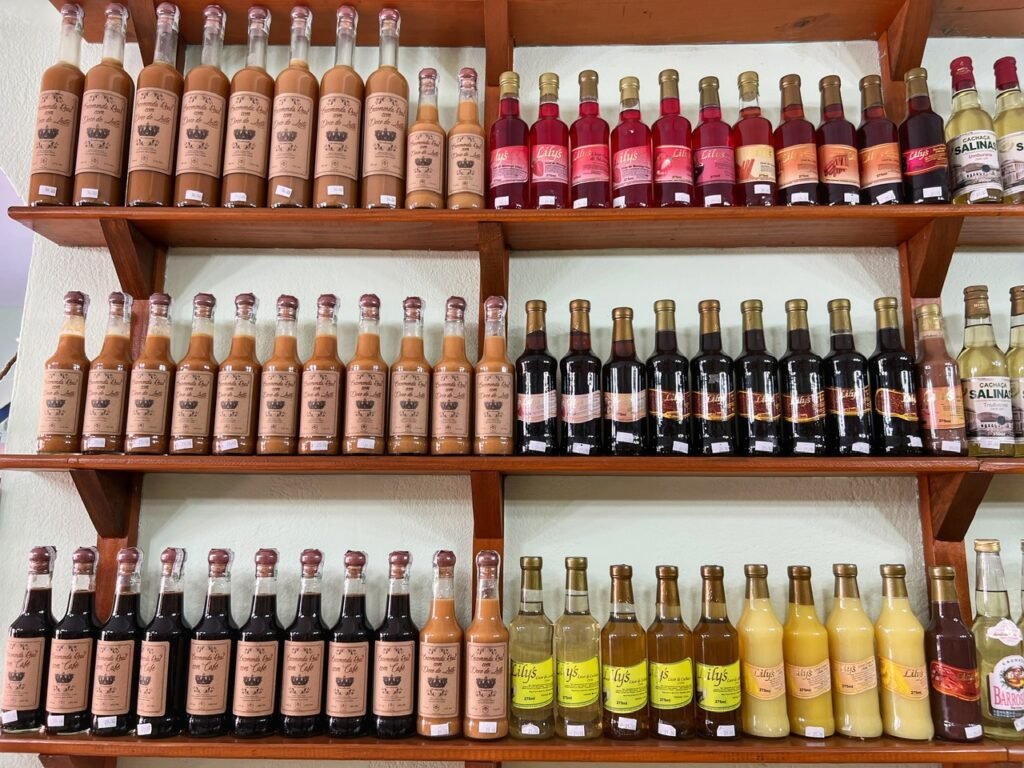
One of our first stops was to one of the many stores, practically museums, of Cachaça liqueurs. We already knew it is a distilled spirit made from fermented sugarcane juice used in the National drink, Caipirinhas. What we weren’t familiar with until Tiradentes was the sheer volume of flavor options of the drink. Yes, this is all cachaça.
If you’re into the more flavorful and less spirit-tasting varieties, flavors range from every type of tropical (and regular) fruit like pineapple, banana, strawberry, coconut, passion fruit, and even our beloved Jabuticaba. If you want a less fruity option, there’s also chocolate, coffee, or cinnamon creme. Even though we’re not usually spirit people, we couldn’t resist these tasty temptations to celebrate Mandy’s upcoming birthday and settled on a bottle of cinnamon crème and Jabuticaba. Each bottle was 29 Reais or $5.90.


Other temptations at the sugar store included rows and rows of candies and dried fruits, and an eye-catching display of preserved fruits. We decided to just slurp, rather than eat, these concoctions.


Taking our prize, we meandered through the town for our first glimpses of its charm, and climbed up the mirador to pop a squat overlooking the town cloaked by palm trees, hundreds of cavorting parrots and much to our delight, a series of solitary toucans which seemed to dart through the sky like colorful missiles.
Or did we just have one too many sips of our new bottles? 🤣 The cinnamon one, Mandy’s favorite flavor, was deemed hers (birthday rule) as soon as she took a swig of it followed by the more Cough syrupy Jabuticaba one. A far blow from the taste of the fruit.
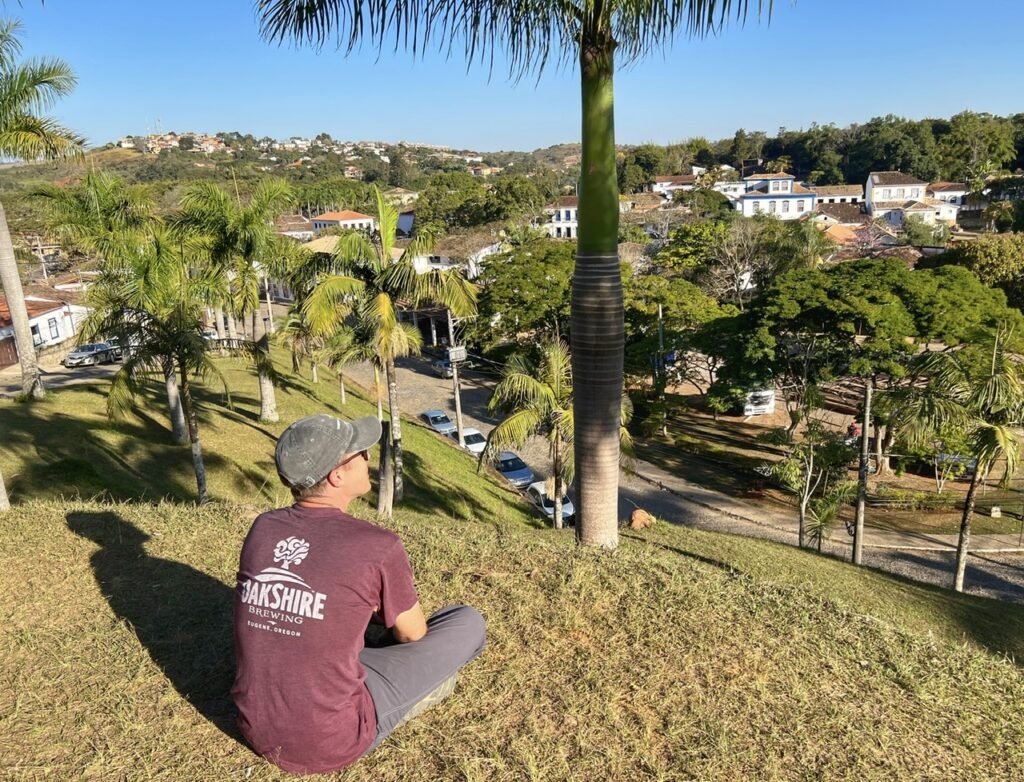

It was an idyllic setting to soak in the terra-cotta rooftops and the sun sinking behind the mountain.

One reason why it initially reminded us of a hokey gold rush town in the States. 🤣

After our sunset, we wanted to visit the Fountain of Saint Joseph, where according to one reviewer, despite it being very old, the water did not give him dysentery. 🤣 This homage to Tiradentes (more on him later) was where travelers stopped to supply canteens and water for their animals during the gold rush.


Behind this fountain is the “Bosque da Mãe D’Agua” which, according to our guidebook, features a 30-minute trail that drops you into a nature-laced jungle dappled with “cavorting monkeys,” according to our guidebook. Since we’re big fans of cavorting monkeys, we tried to go three times, and each time, the door to the magical monkey land was locked. However, we did steal the fun word to use on the parrots (see above.) We also played a little Alice in Wonderland as we spied through the peepholes onto the magical trail. Dang.

In addition to cachaça, Tiradentes is speckled with multiple cheese shops. Brazil, particularly this state, is one of the few places in Latin America that seems to make really decent cheese. They also have aged ladies out front which coincides with the aged quality of some of their options.

While in Tiradentes, we stayed four weeknights at Pousada Santo Expedito and had a wonderful experience. Because we came through the week, we got a highly discounted rate of about half off. We’ve heard NOT to go here on the weekend because it’s an absolute zoo. The benefits of slow travel indeed.


The simple room was $27/night down from $55 and included the best pillows we’d had in a long time (a big deal for us!), very hot water and a mini fridge. But the icing on the cake (literally included) was the beautiful breakfast buffet spread where we gorged filling our bellies until mid-afternoon each morning. Let’s just say we ate very very well in Tiradentes.
Exploring & Eating in Tiradentes Town
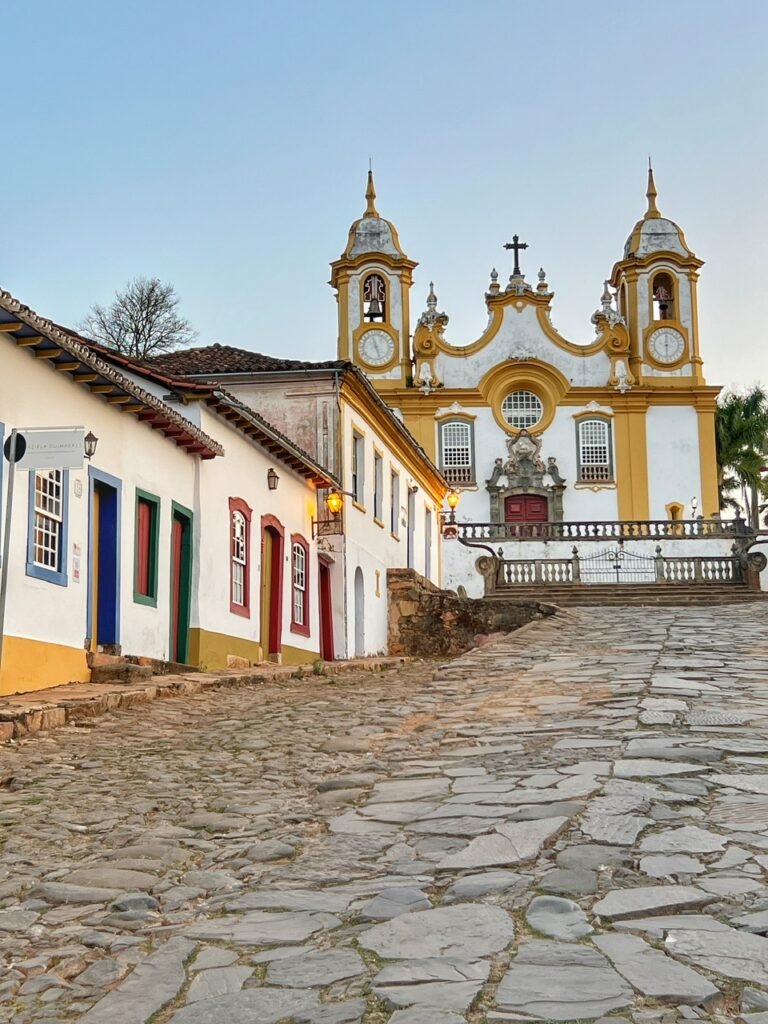
Tiradentes is a gold mine in many senses of the word. Nearly completely off the radar for most international travelers, the rural colonial gem, home to only 7000 people, was once a booming gold town. Today it is replete with outdoor wandering, artisan goods and crafts, and the second-best cuisine we’ve sampled in South America (Peru will forever hold the prize.)
While it doesn’t offer the colorful palate of Paraty, nor the distinguished elegance of Ouro Preto, there is something very quaint and authentic about the way the white facade and terra-cotted architecture blends into the mountain backdrop and the bluebell skies. In short, it was one of our favorite stops in Brazil.
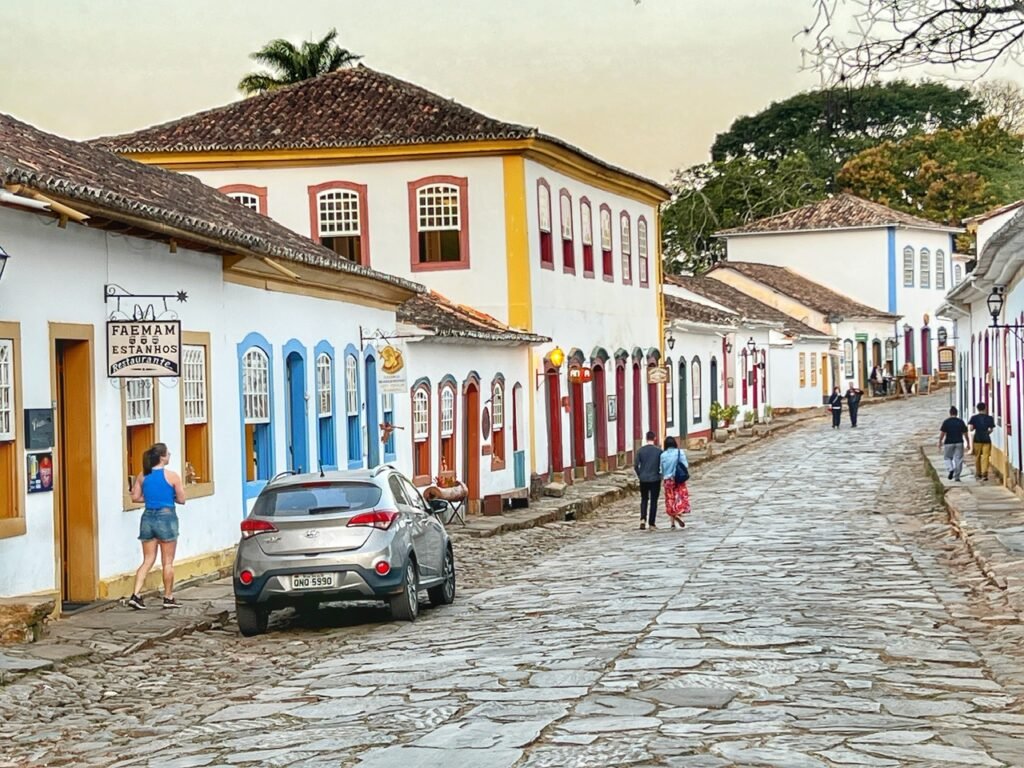
The center of Tiradentes is a compact cluster of cobblestones in which nearly every street is photogenic. Our guidebook advised us to go during the weekday to avoid zoos of local crowds and to fully appreciate the town’s abundant attractions. We arrived on Monday when it was nearly desolate and left on Friday when the steam train and tour buses were rolling in so this was a very good call for us.
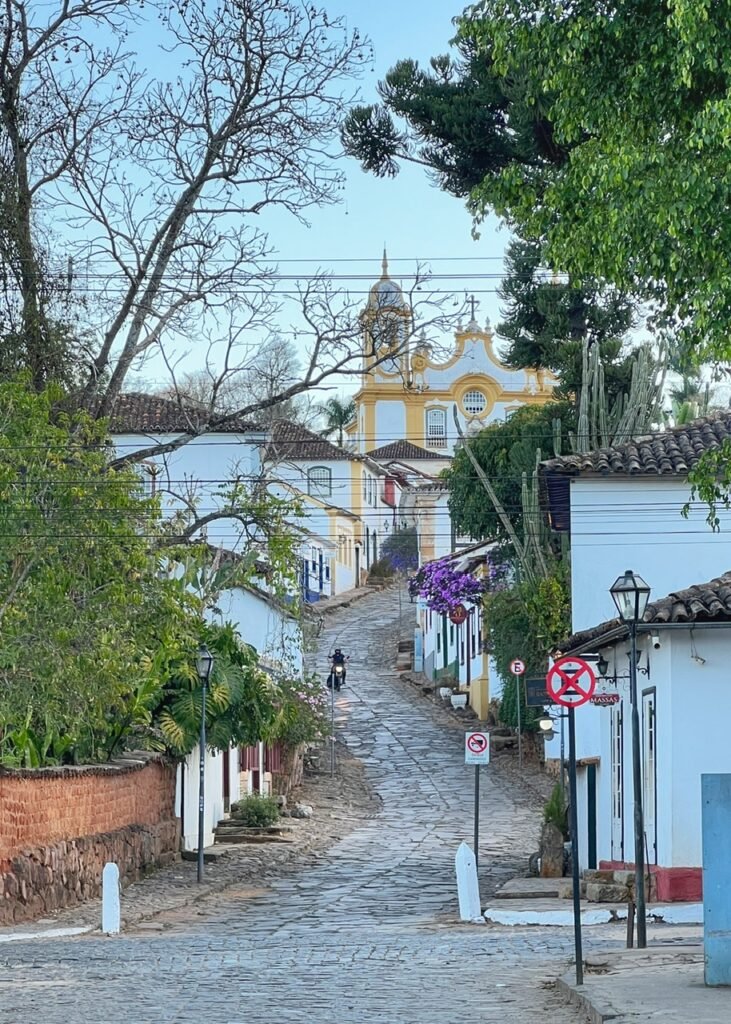
A winding street up to the dazzling gold showpiece of Church of San Antonio.
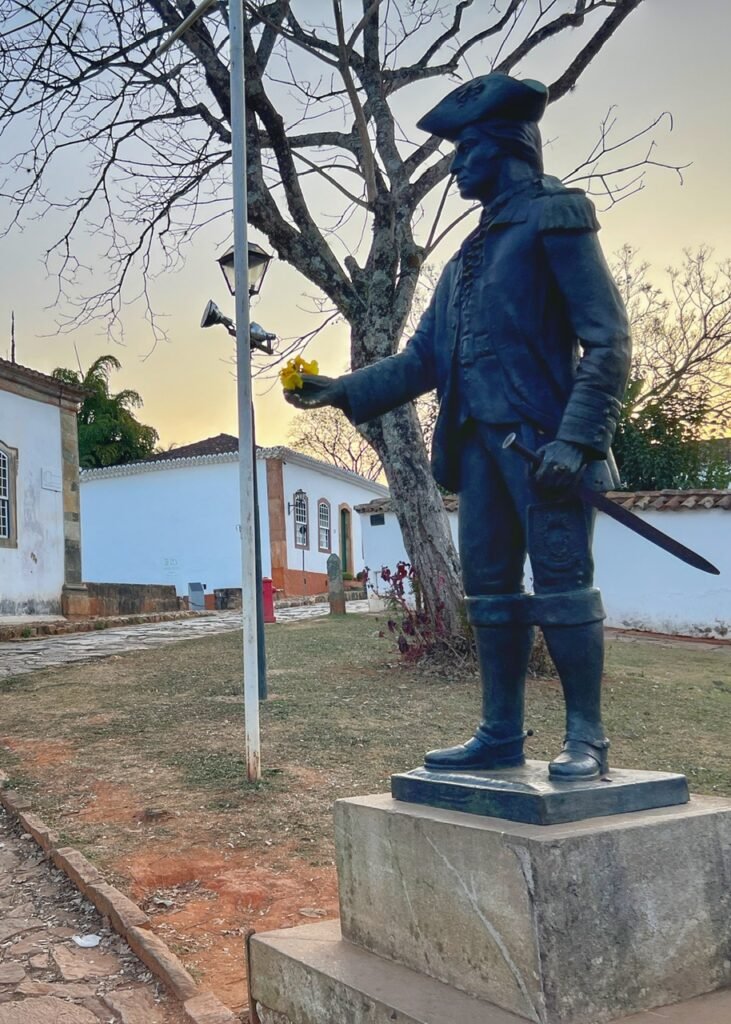
Tiradentes was named after this dude….the Brazilian patriot Joaquim José da Silva Xavier, nicknamed Tiradentes (“Tooth Puller”), because one of his occupations was dentistry. He was born in a nearby farm.


The town and surrounding areas have been a magnet for artists and artisans for centuries, where a sweeping tree of life fills the center square of the village.

Two guys plopped at a table sipping chop (draft beer), a very common activity in Brazil as public consumption is allowed pretty much everywhere. In the background, you can see the town is crowned by Serra de São José, a magnificent and massive mountain wall that looks like a stone tsunami rolling towards the idyllic village.

Now this looks inviting…The golden trumpet tree was currently flowering all over Brazil making the skies even brighter.

Tiradentes has so so many adorable pousadas, or inns to stay in.
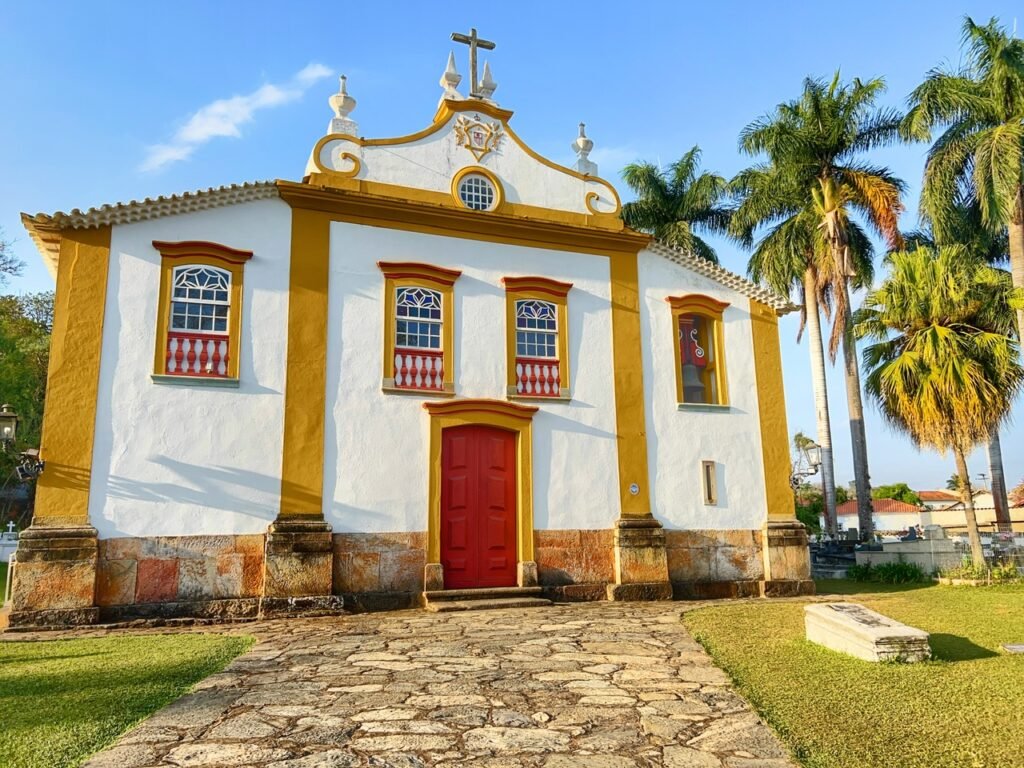
What we called the Toucan church, because it’s where we saw several. More officially it’s called Igreja Nossa Senhora das Mercês.
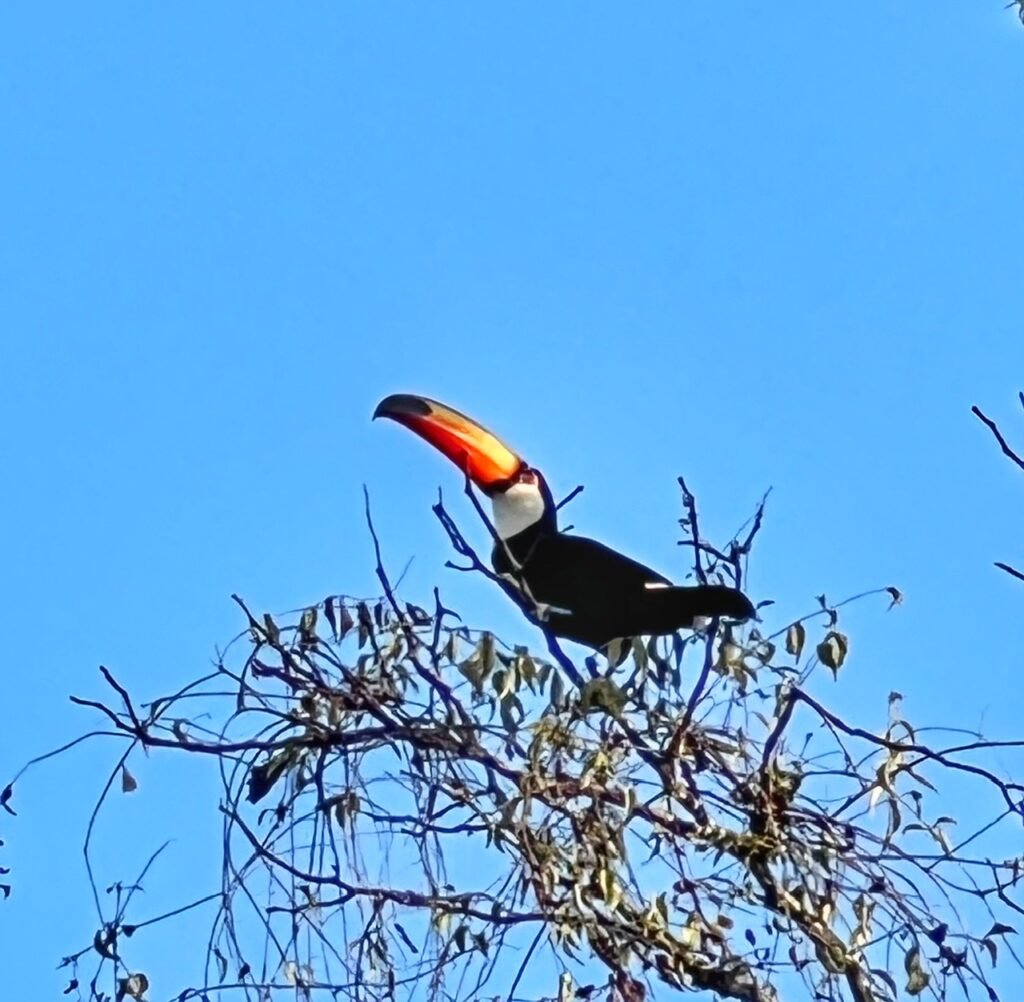
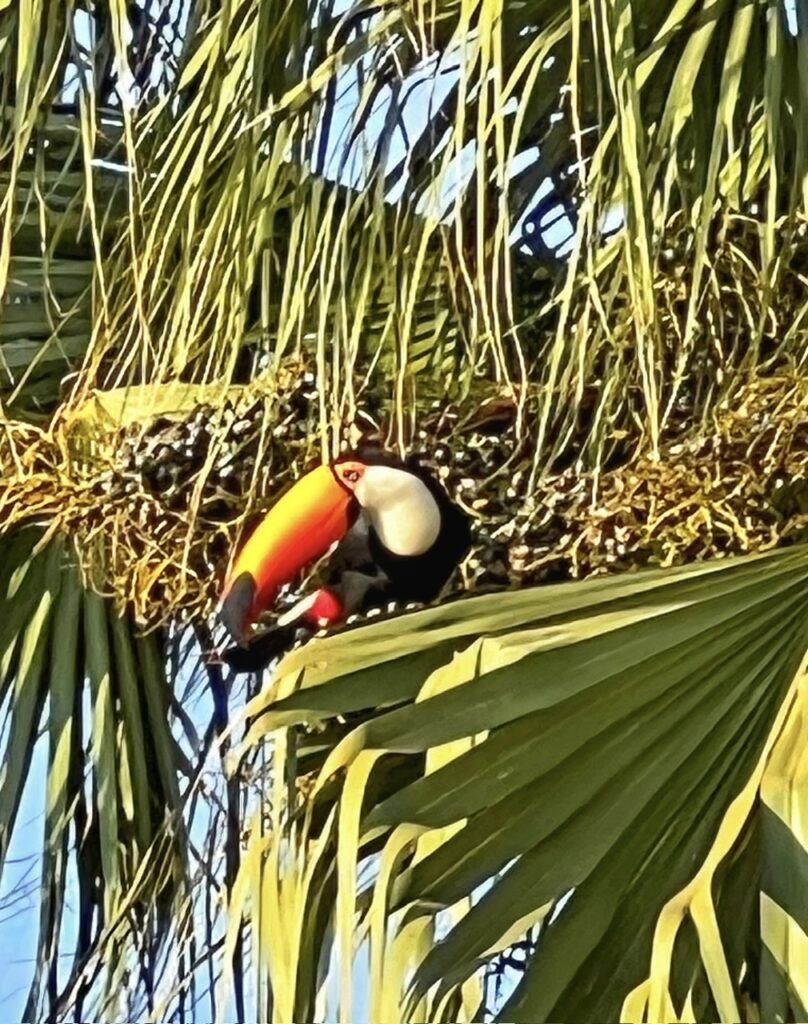
Speaking of, whether you think toucan, or toucan’t, you are right! 🤣
It’s hard not to turn into a birder when exotic toucans are plunging through the air like colorful missiles and parrots and canaries are zipping around your head. We’ve never seen so many in one place as here, although we’ve certainly tried.
A few facts about toucans:
- their bills are typically four times the size of their heads.
- they can fly up to 40 mph (65k)
- they eat insects, tree frogs, lizards and even fish aided by their 6-inch-long tongue
- they can be a bit bratty with other birds
- they are incredibly important for rainforest health because they pass seeds from the fruit they eat through their digestive systems, which helps replant the plants



More street scenes of Tiradentes…

The only beef we had with Tiradentes was the fact that they allowed motorized vehicles inside their historic center. It would have been much nicer if they’d followed Paraty’s model and stuck to pedestrian-only…
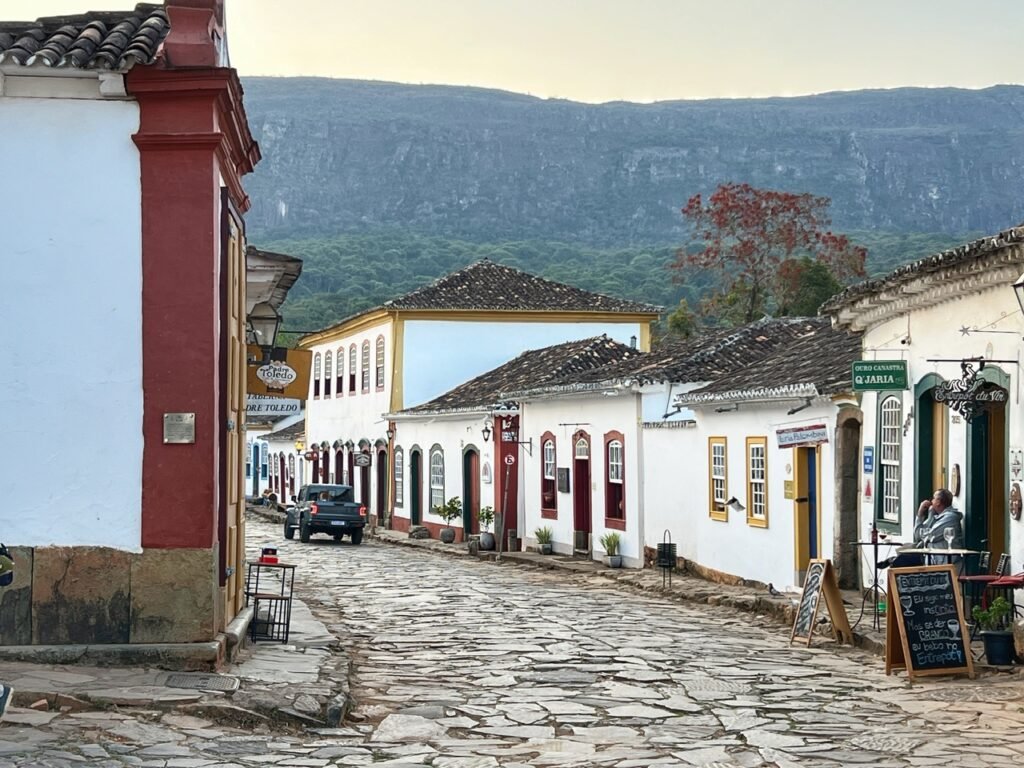
…because there’s nothing like teetering delicately over shoe-eating cobblestones and nearly getting mowed over by a scooter.

Other than that, although it looks a bit steep in this photo, Tiradentes is incredibly level unlike other towns of Minas Gerais.

This church was named Igreja de Nossa Senhora do Rosário dos Pretos…Our Lady of the Rosary of Blacks. While the slaves built almost all the churches, this was a church, built by and for the slaves in 1708. Since they had no free time during the day, construction was done at night. Inside the gilding of the altar was covered in gold that they collected from their hair and fingernails during their long days of forced labor.

Of course, this queen was a nice one. By the way, you might notice the headless king beside her is giving a thumbs up. We’ve never been in a country where the “thumbs up” sign is more used than in Brazil. (Note: the 👌 sign on the other hand corresponds to homosexuality, so better to avoid unless you know what you’re doing!)

Barbie and Ken’s carriage of amor. Every morning the square is lined with these. We read on the weekends the 💩 can get a bit toxic. More reasons to visit during the week. 👍🏻

When you escape from the center heading west, you can find the Sanctuary of the Holy Trinity.

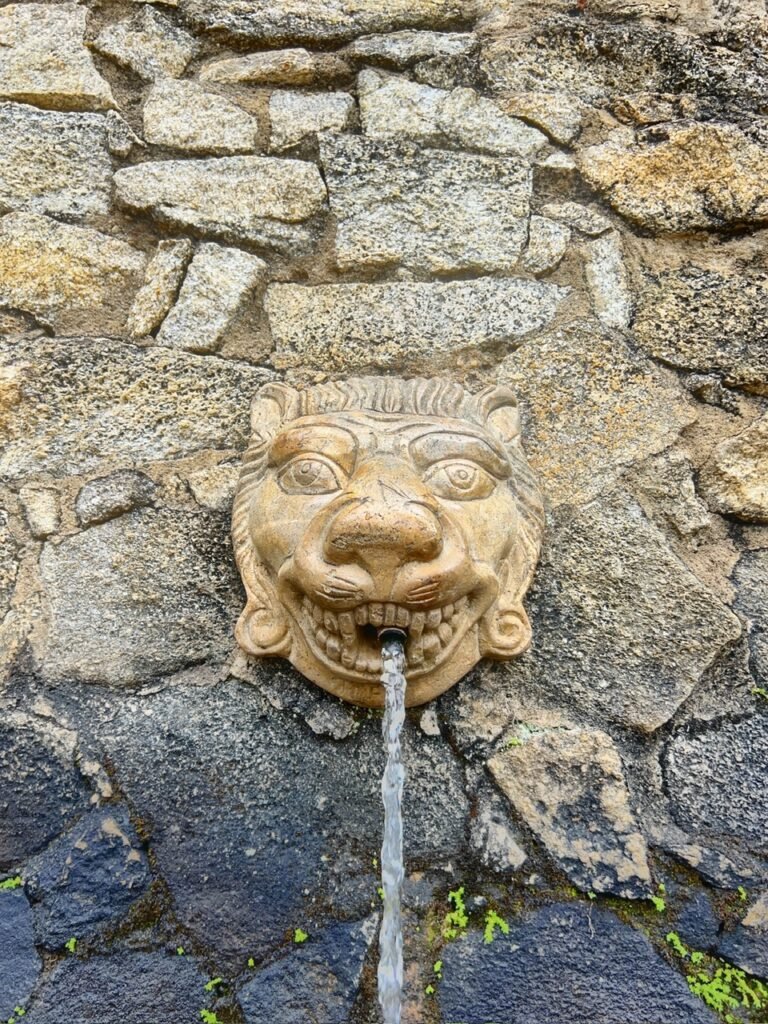

It has a lovely fountain out back where would be a peaceful place for a picnic.

Nearby is also lined with new houses made to puzzle in perfectly with the authentic charm of the center.
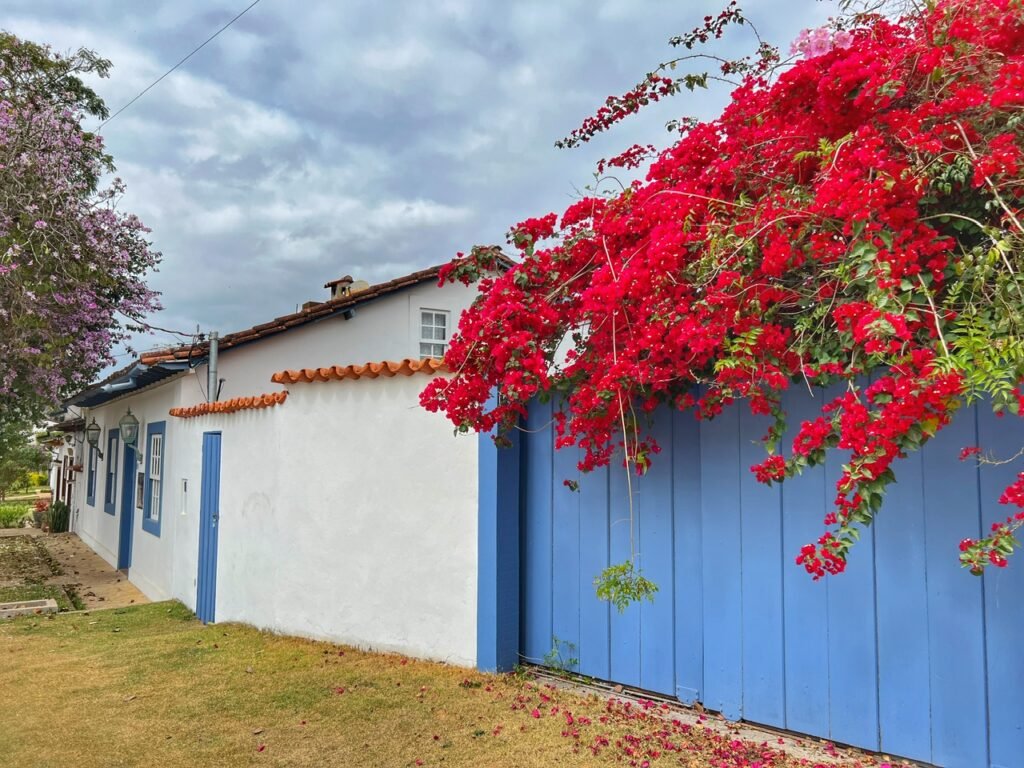
And you can’t have charm without bougainvillea. Seriously, it’s a rule.


The back of the main church in Tiradentes, Santo Antonio built in the late 1700s, as well as some of the intricate details.

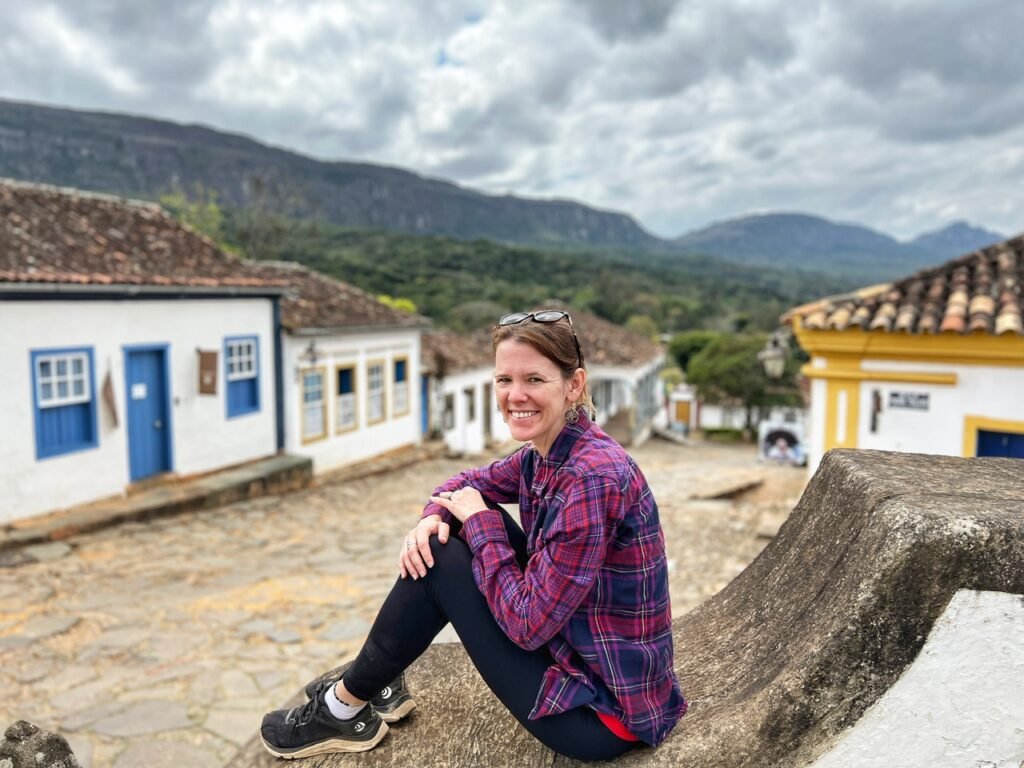
We had just finished a pretty long hike when we visited so Mandy was keen to just ogle it.

In the meantime, Greg ran around taking photos of the exterior and the famous sundial which dates from 1785.




For Mandy’s 43rd birthday dinner, we splurged at UaiThai, which was supposed to be a Thai/Minas Gerais fusion., since we’d seriously been craving Asian food.
Our Pad Thai had only a (very small) touch of Minas Gerais flair. It was found in the little green tapioca balls, the oddly placed curly pork rinds and the marinade for the shrimp, which was made from Bixinho’s artisanal cachaça, the predominant spirit in Brazil. It cost $45 and was well worth the birthday splurge.
By the way, with a minuscule population of 7000, Tiradentes is a true foodie destination. It has more starred restaurants per capita than any other city in the giant country of Brazil. Five to be exact. It also offers some of the best food we’ve had in South America (minus Peru) in its traditional mining, or Minas Gerais cuisine.

Many people who visit Tiradentes arrive by historic steam tourist train from nearby São João del Rei. It only runs on the weekend and costs 70 Reais ($14) a person for the 30-minute journey. We chuckled at this and enjoyed our $1.20 local bus ride instead.

Although daytime temperatures were quite pleasant, it got a bit chilly at night. We loved how all the restaurants rolled out their heat lamps and furry blankets as soon as the sunset.
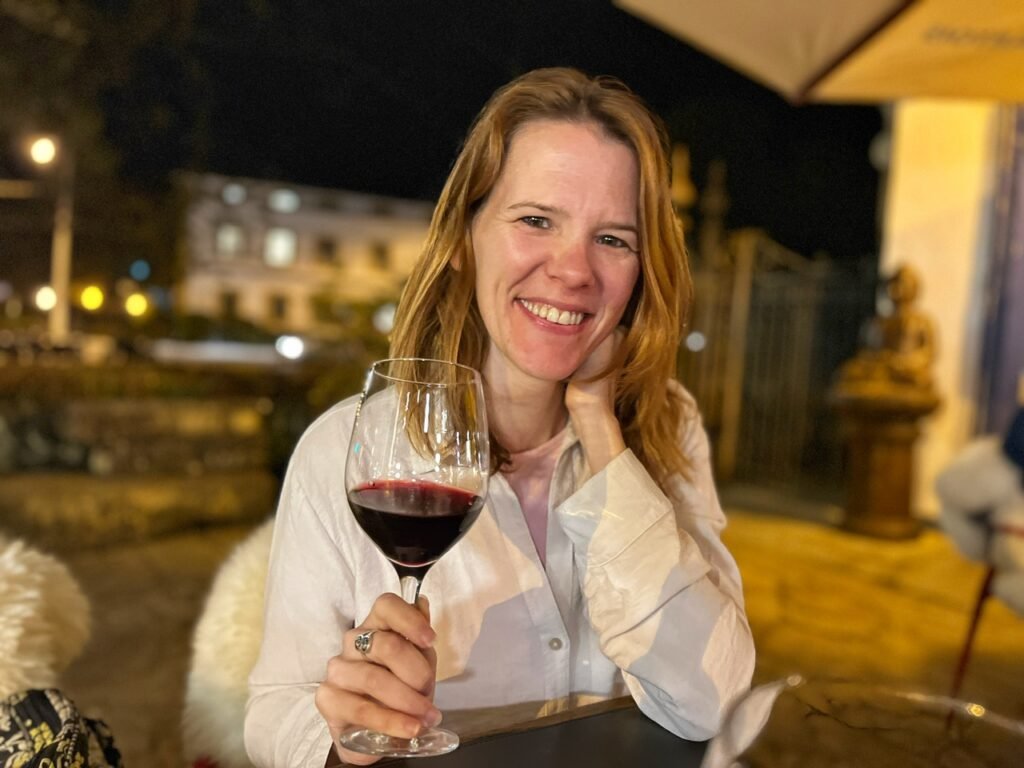
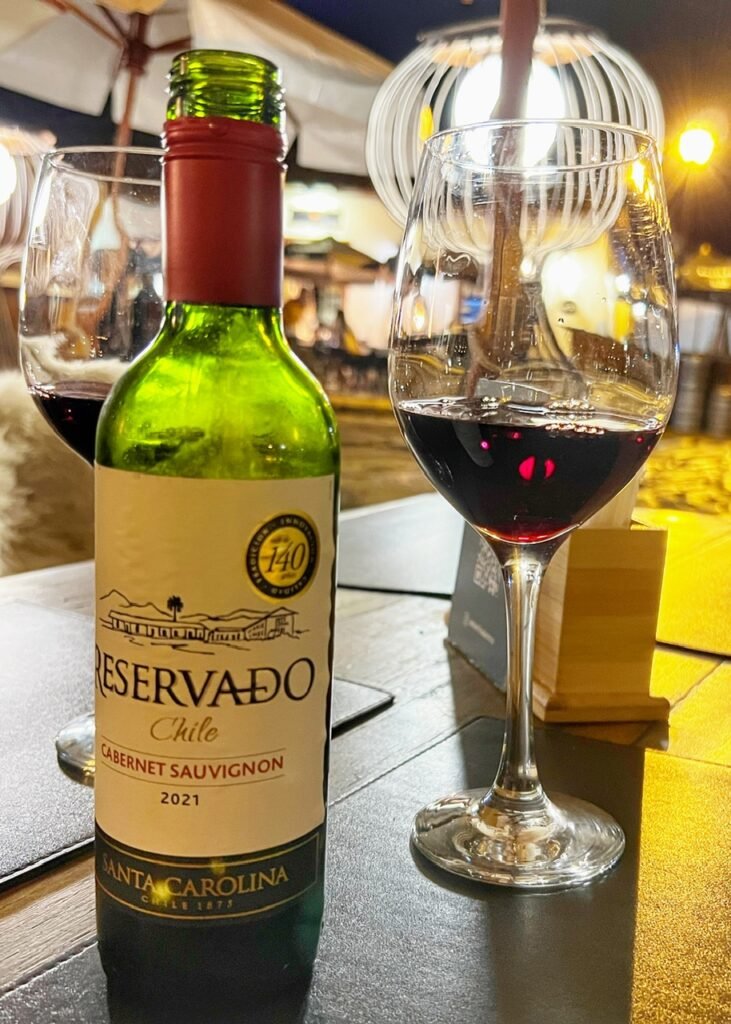

It definitely enticed us to stay awhile to “splurge” for Mandy’s special day. (A half bottle was $10 so still very reasonable!)

Mandy’s birthday cake. While in Brazil, açai bowls were regular healthy fare for us, but on this particular day she decided to be a bit naughty and added some birthday goodness…sprinkles and chantilly. $4.50
Hiking in Tiradentes

Yet another reason we loved Tiradentes is because, off your doorstep the nearby mountains are threaded with (incredibly safe) hiking trails with interesting terrain, as well as natural and manmade features. These trails are all part of a bigger trail network that goes from Rio de Janiero to Belo Horizonte and seems ripe for discovery. But considering we don’t have months, we instead chose two main trails, both of which could be accessed by our trail mapping app… the first was Trilha do Mangue and the other was Calçada dos Escravos.
The Calçada dos Escravos, rated moderately challenging, is about a 3-4 hour, 9k out-and-back trail in the northeast part of the village. It weaves you slowly up to the mountaintop and according to the map, to two waterfalls, which weren’t exactly flowing this time of year. Most notably, it allows you to traverse down an old stone-paved path built by slaves between Ouro Preto and Rio de Janiero.


Getting to the trailhead itself if a bit of adventure so make sure you plug into a mapping app. (We use Mapy.cz)


Based on the depth of trail, clearly made by horses, it has been used for centuries. How many tired and quite feasibly, barefeet, have traversed these stones?

A lovely vista near the top offered views towards Tiradentes.

A fuzzy wuzzy plant…we couldn’t find the name.


The trails were mostly very well-marked. Once you got to the top of the ridge, the terrain leveled off and it felt a lot like the high desert of the US Southwest…

…except for the minor detail that we were walking on layers of quartz.
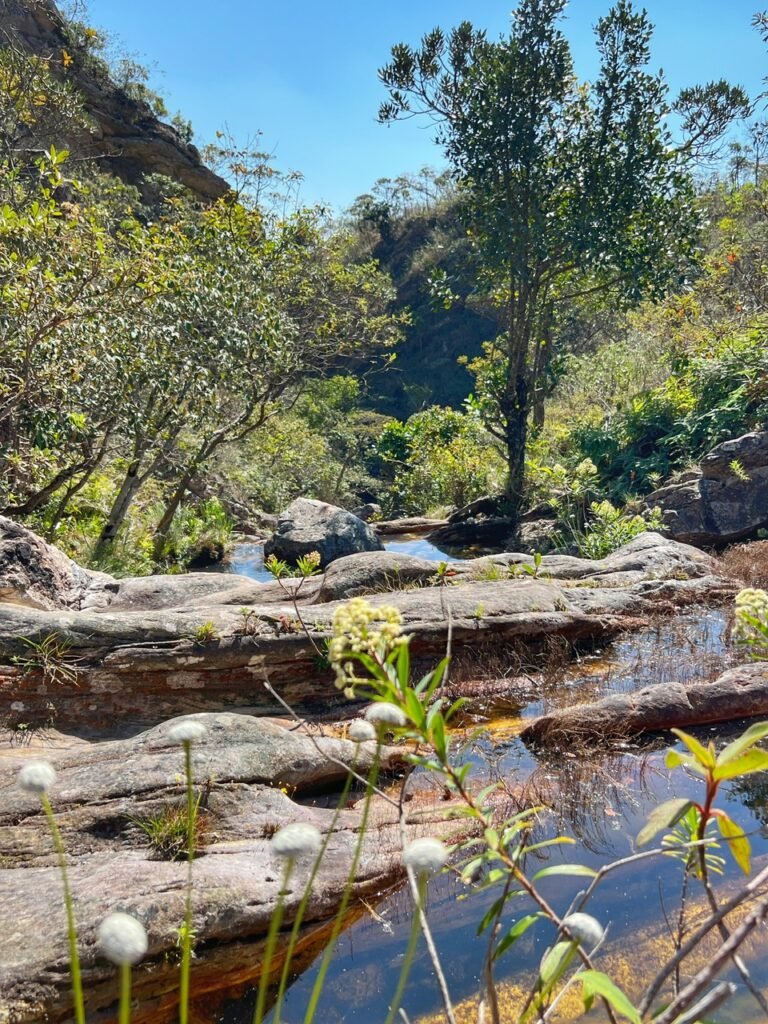

The waterfall, not really a waterfall, was more of a water feature. Regardless, a nice place to have a picnic.

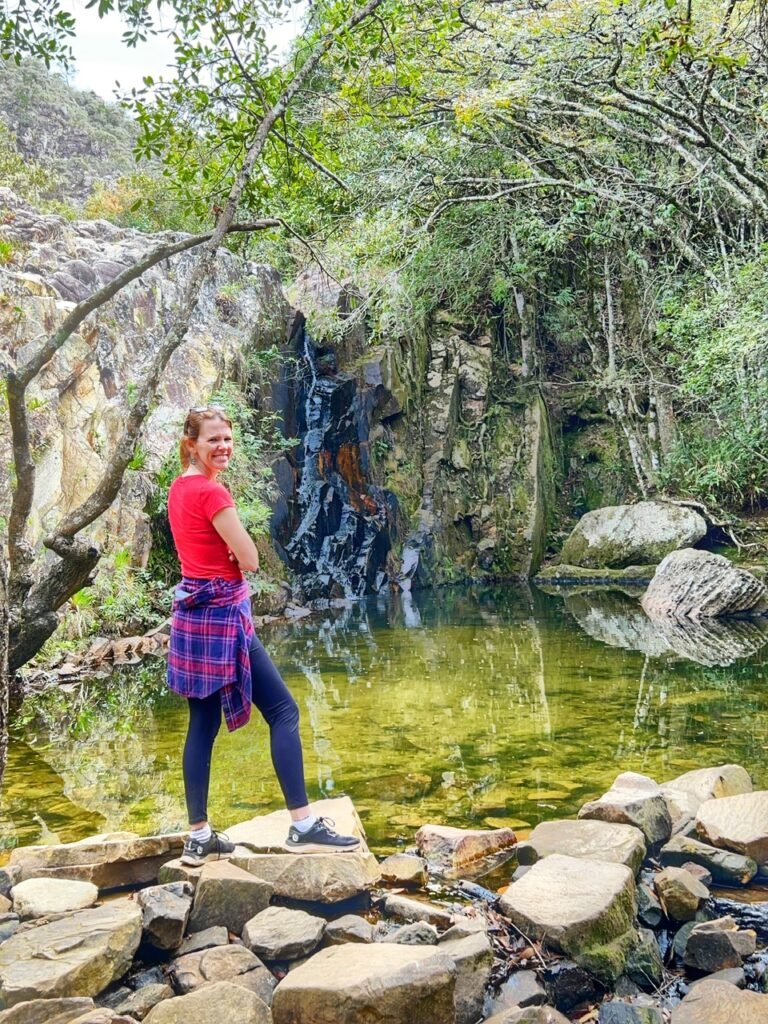
The second trail, Mangue gives hikers the opportunity to visit the Mangue waterfall (4 km) or make it a loop and visit two additional ones (~12 km) We, of course, chose to do all three. Again, it had many sections which showed a lot of history. The Mangue waterfall is also where Mandy took her 43-year-old senior, soon to be the other senior, photos.

The ebony color of the rock mixed with copper was so striking.
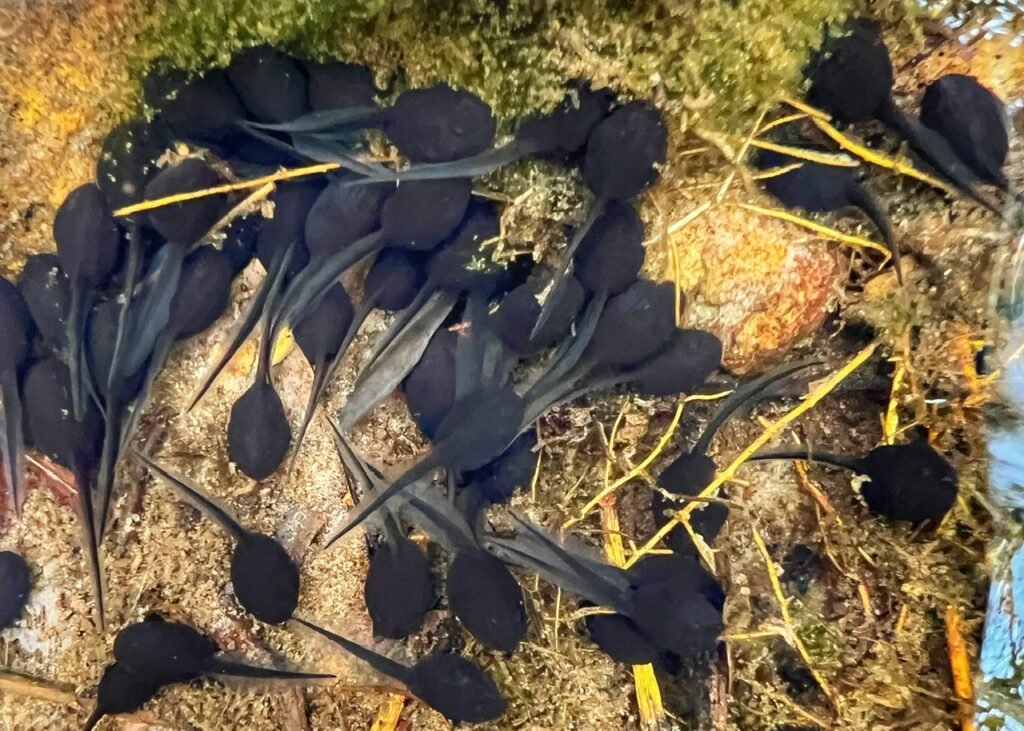
And tadpoles were everywhere!

The second waterfall had some of the same beautiful features…
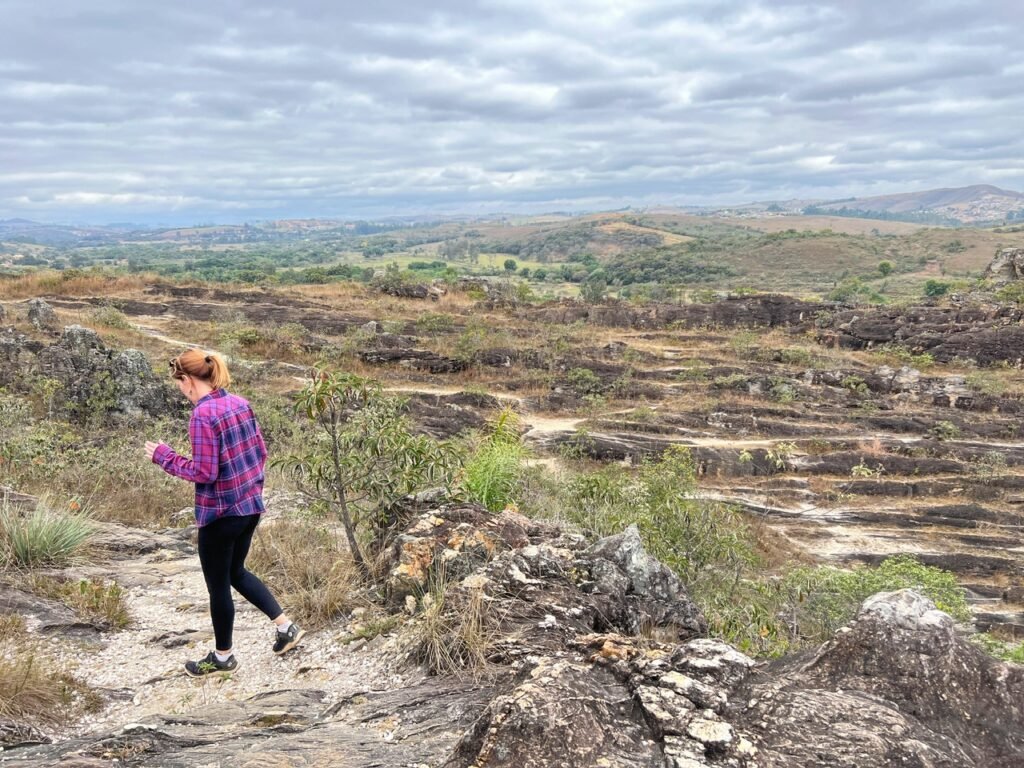

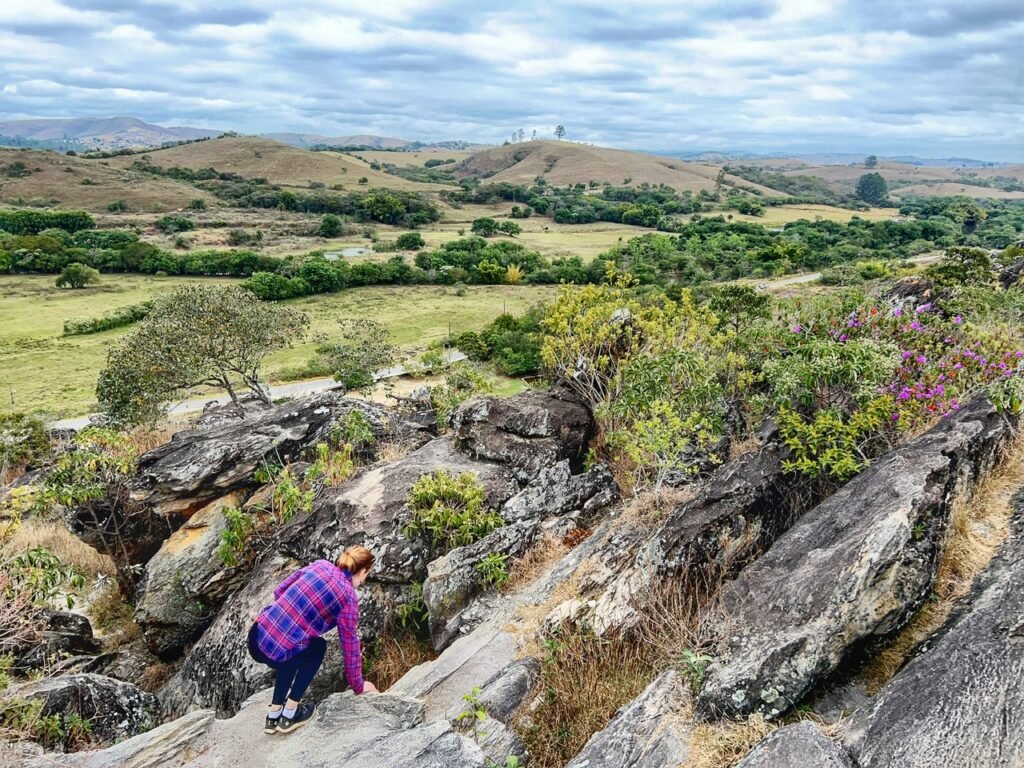
…as we continued through some quite jagged landscape towards the third.

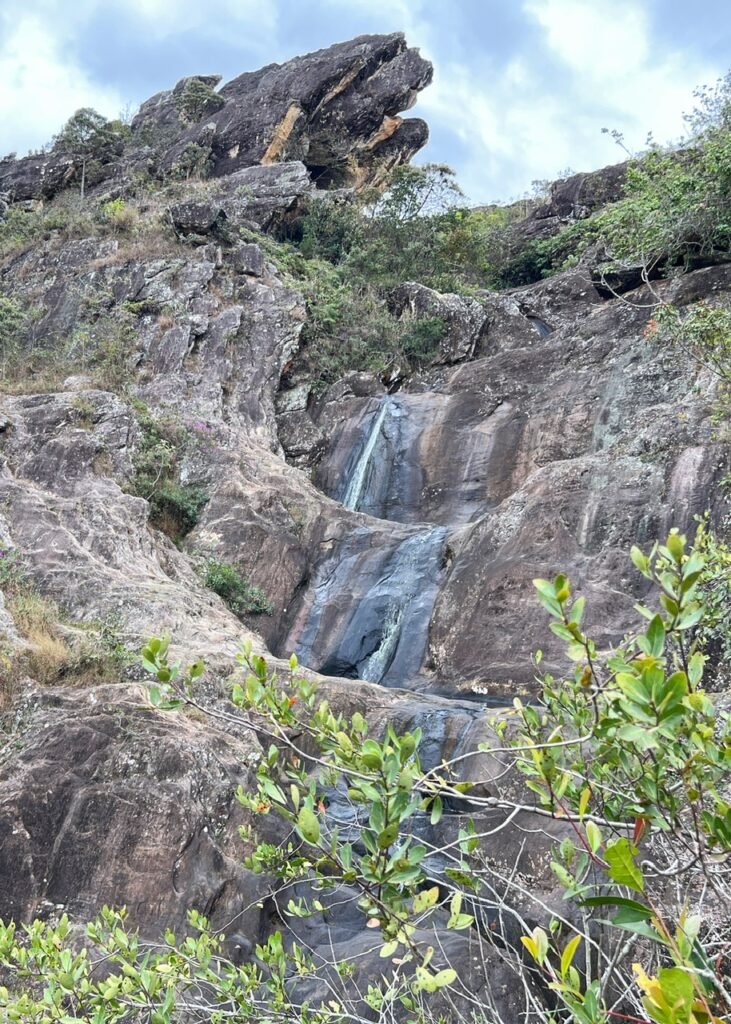
Towards the end of the trail, and the final waterfall, there was a lot of scrambling. The third waterfall was actually 4 in one with layers of pools. It reminded us a bit of the Seven Sacred Pools on Maui.


When the trail spit us out on the main road, we took a look at what we had just come down. Suddenly you’re face to face with an elaborate sign near the next town over, Santa Cruz de Minas. From here it was all along the road back to Tiradentes.

The map of the second hike.
The Walk to Bichinho for the Best Meal…in a LONG time
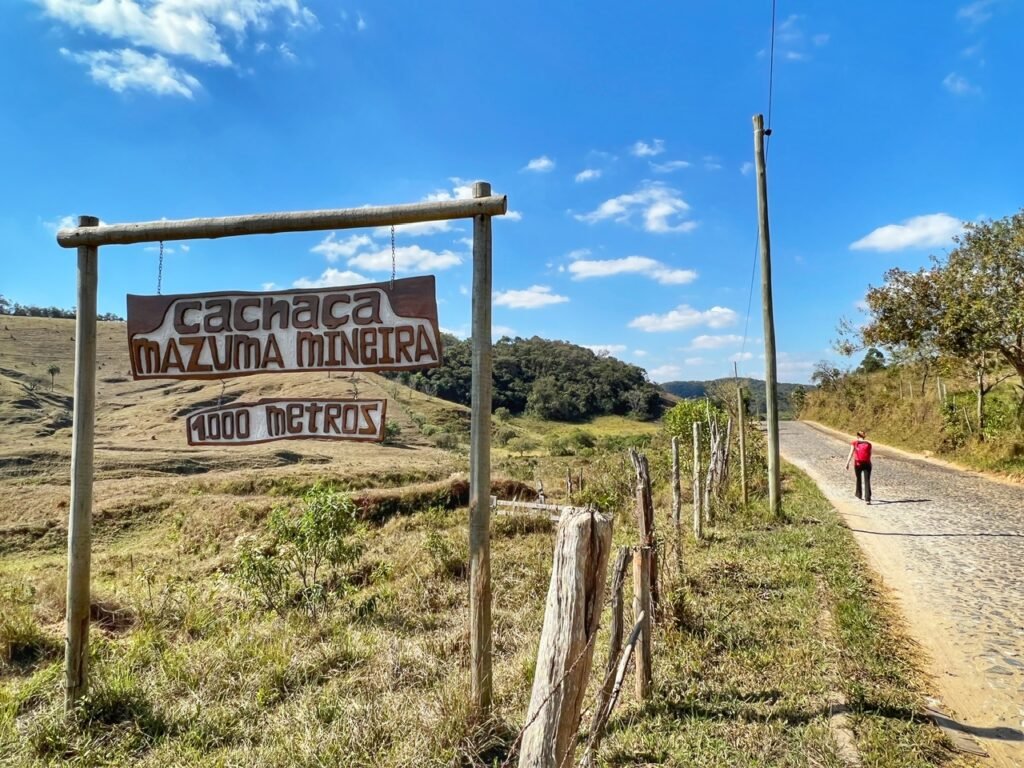
Our final and favorite adventure from Tiradentes was meandering down a nearly 9 km cobble-stone road to the village of Bichinho. If you’ve never walked 9k down cobblestones, it’s very tiring on your feet and murder on your shoes, which we’re both trying to hang onto until December. That said, we weren’t thrilled there was no bus on the other end to return us.
Fortunately, a friendly local offered to bring us back after we’d walked about 1/3 of the way which was a very good thing considering the uncomfortable food coma we found ourselves in after our Minas Gerais buffet feast.

This walk (photo above) was more than the prize of stuffing our faces, however. In addition to beautiful countryside, along it we also found all kinds of colorful curiosities, unusual architecture, whimsical art, a car museum, and distilleries with free cachaça and gin tastings.

One such oddity was the quirky Crooked House which was designed by theater artists and inaugurated in 2016. It is a cultural space with playful and interactive activities for all ages.
The architecture was inspired by the WonderWorks and Ripley’s Believe it or Not. It was unfortunately closed when we arrived, but we enjoyed seeing an icon of our youth, pogo balls, dangling from the ceiling inside.
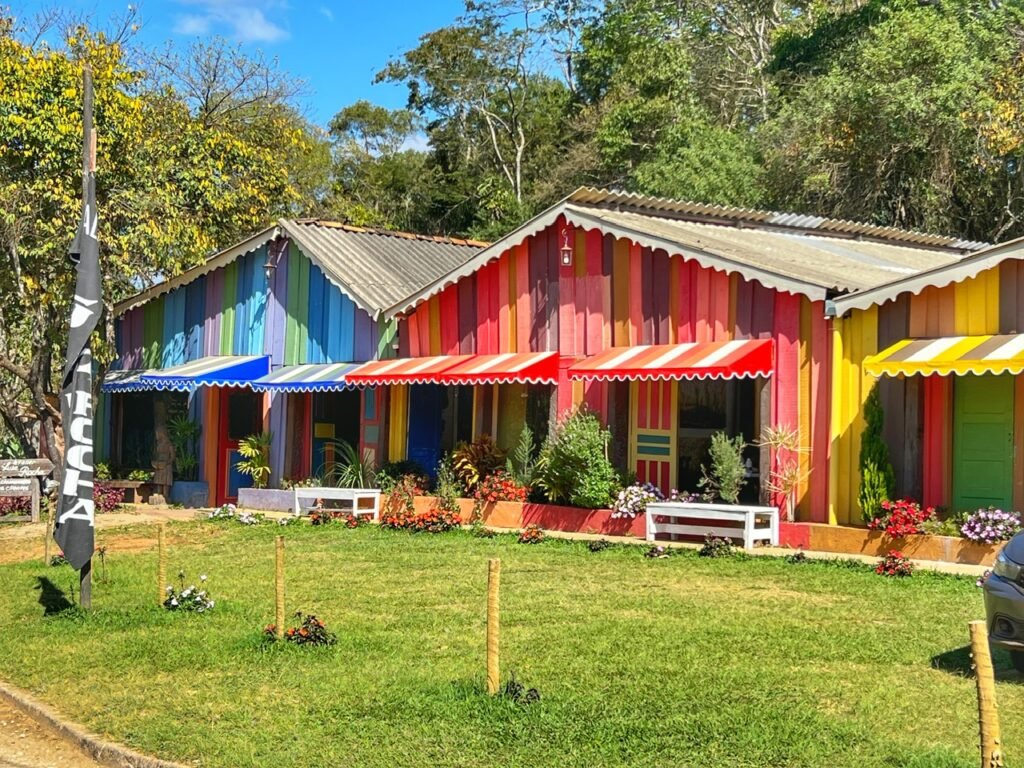
Houses clearly made from Pantone paint swatches.

Eccentric stores with odds and ends.

Mandy climbs aboard an early model of Brazilian public transportation at the auto museum.



A traditional house made of mud…and brick. Actually, it’s mud and brick! How interesting.

And a wheeled cart made of straw the obviously fell out of yesteryear.

A peaceful pousada perched on a hill.



Along the way, we passed dozens of artisan shops, specializing in stonework, woodwork, jewelry and other crafts. Still on cobbles, thankfully mostly flat…and only a kilometer from our first tasting destination. We were both happy about that.
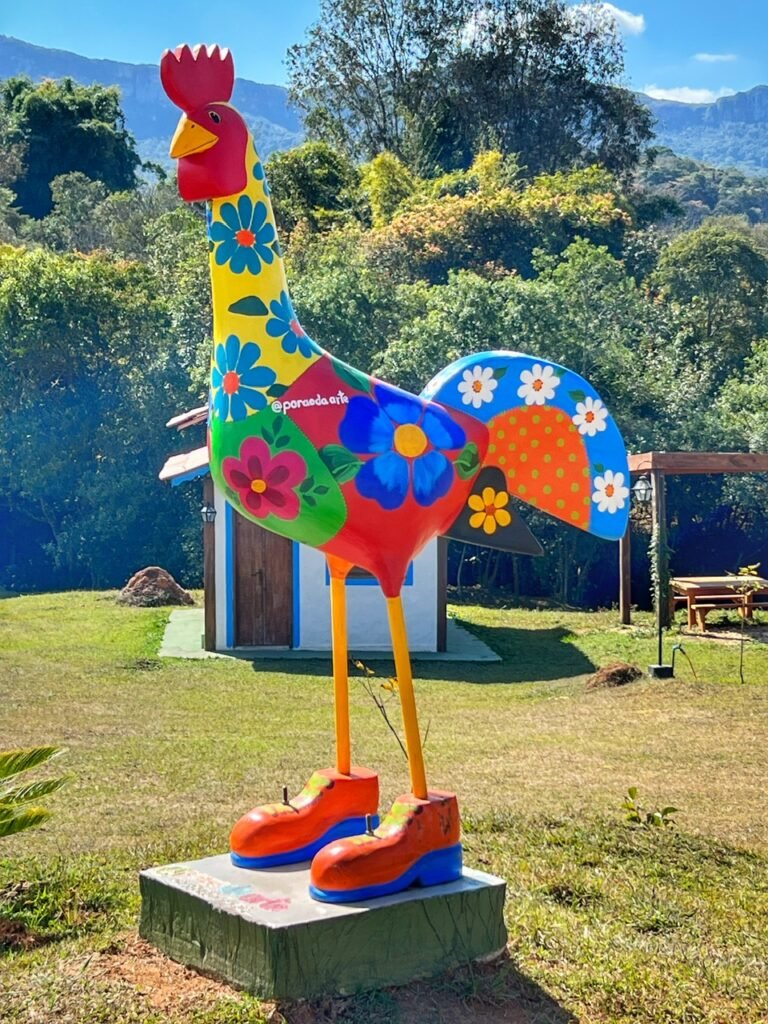
So was this frango. (One of the first Portuguese words we learned!)
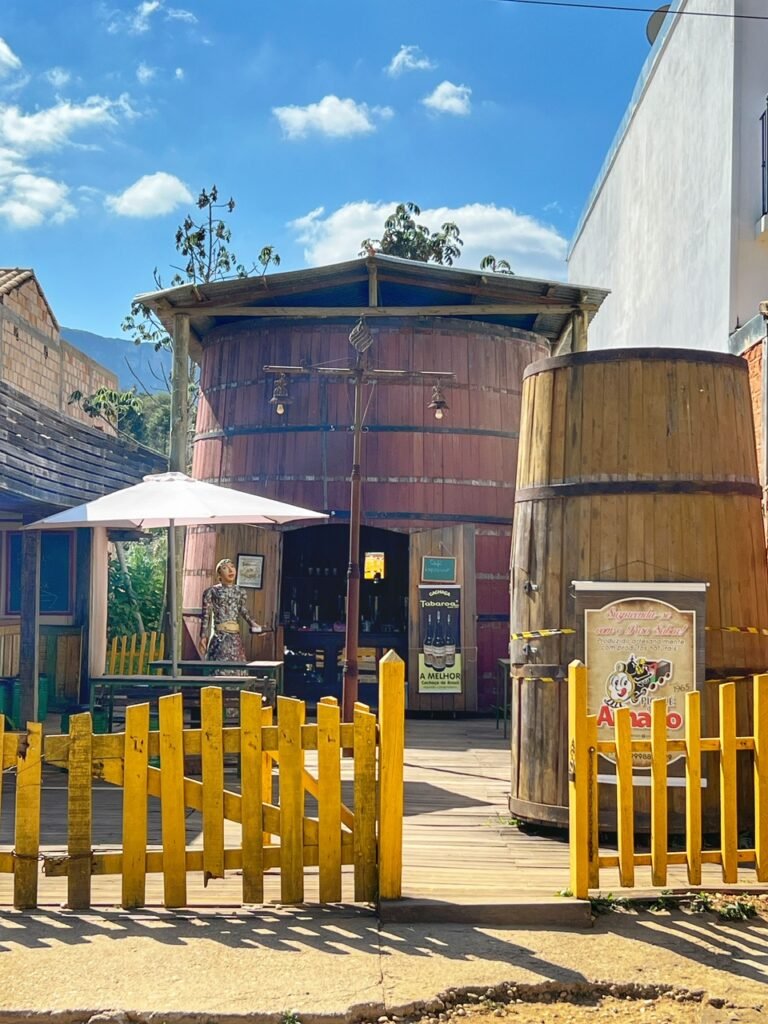
The first distillery looked like a giant funhouse. Of alcohol.

A bizarre brick wall looks like it’s pasted between two different worlds. Um…wonder who the spiteful neighbor is?
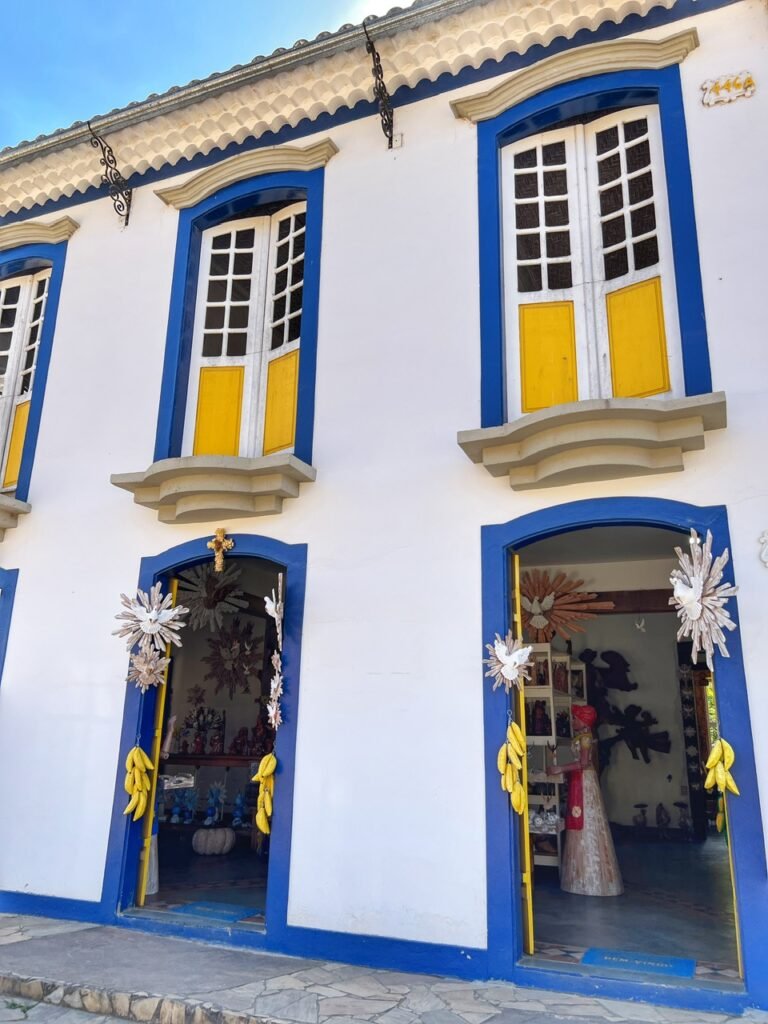
Uhhh…remind us not to walk out of those upper balconies!? 🤣


No one was there!! Except this lone stallion who broke free from the carousel.
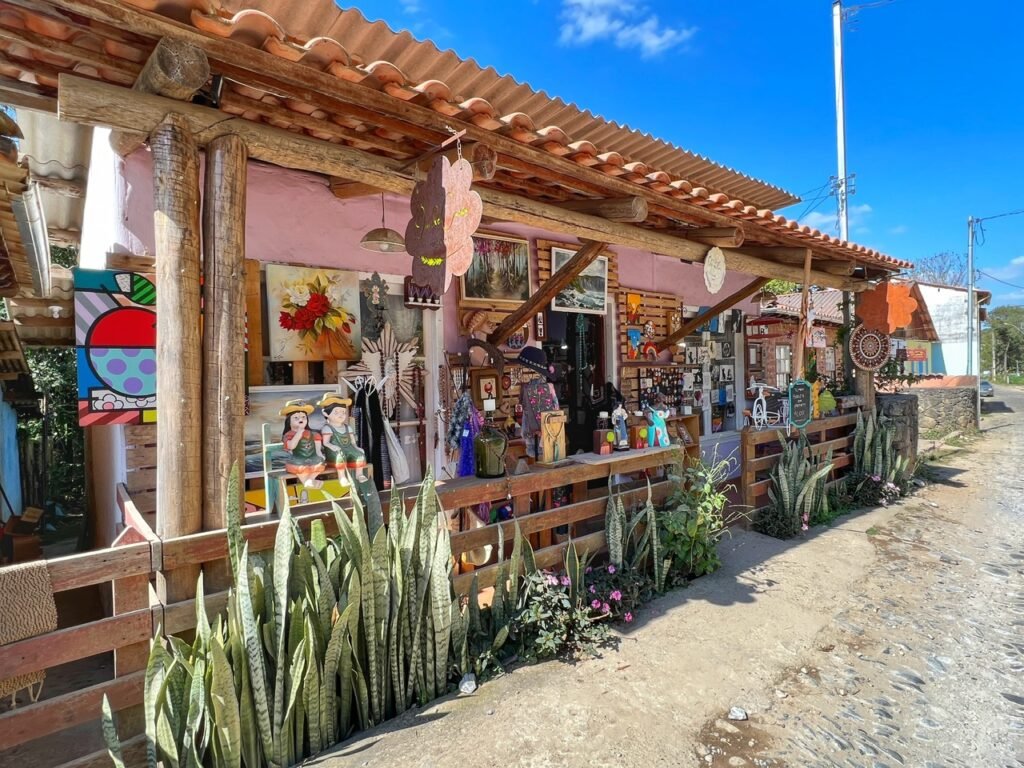

Yet, so many art galleries…and even tributes to Latin American greats.
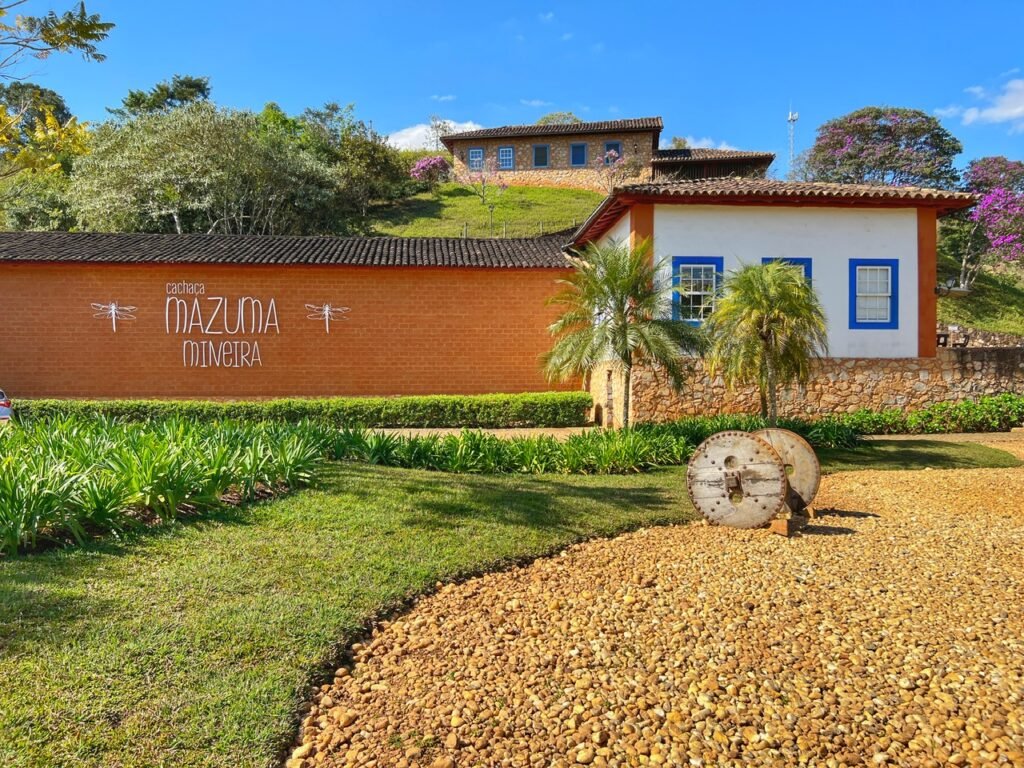

We arrived to Mazuma Maniera, which was actually open! It was here that we received free tastings of high-end cachaça. The Brazilians who did the tasting with us laughed pretty hard when they found out a bottle cost 190 Reais ($38) and our guidebook also said it was seriously overpriced.

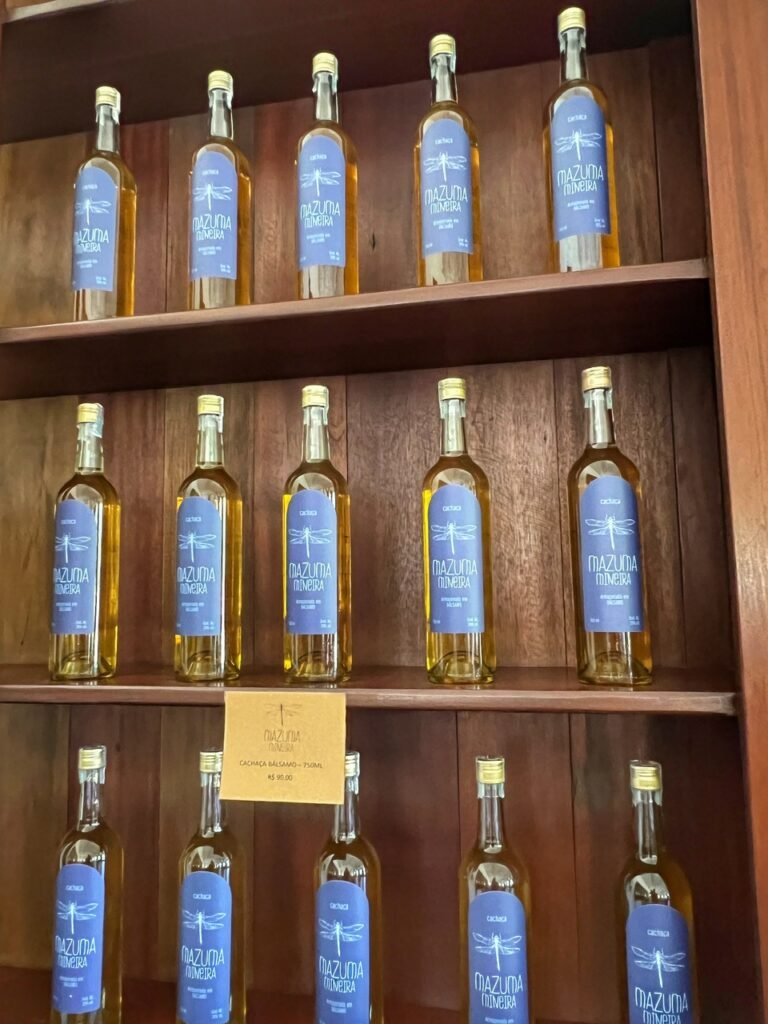
Where the cachaça is aged, mostly in oak barrels. Our favorite taste was surprisingly of the gin…which we’ve never liked before in our lives!

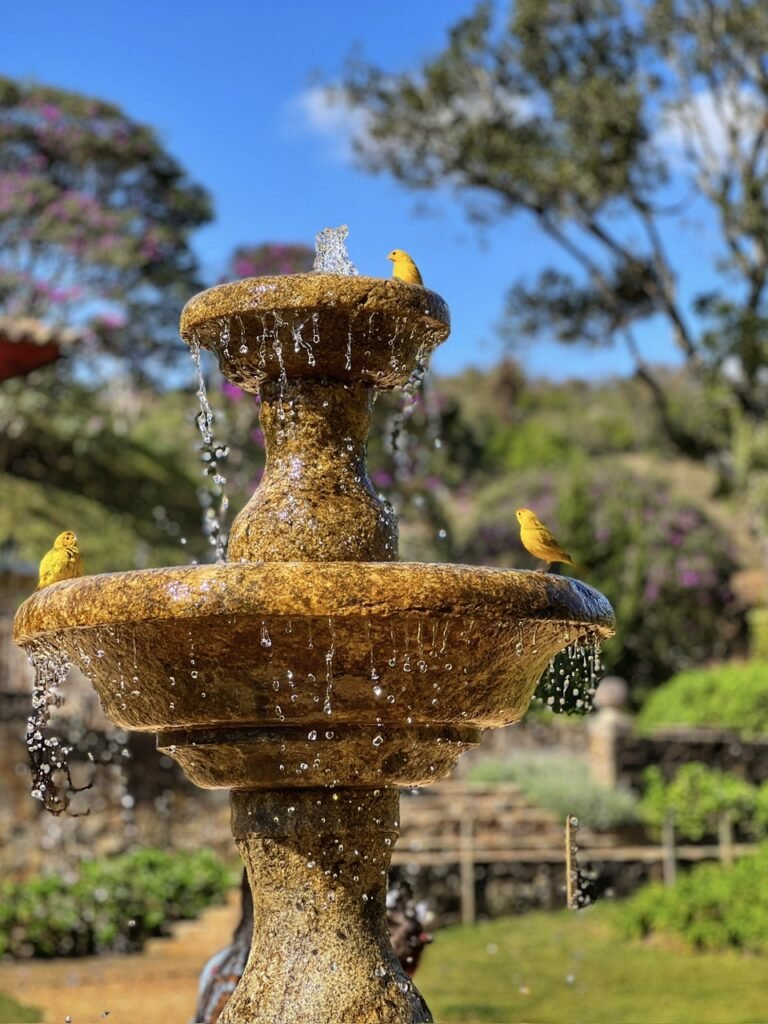
Greg admired the shiny distillery equipment, while Mandy admired the canaries in the fountain. It’s so nice to see these birds free and flying everywhere in Brazil, when they’re so often seen as caged pets elsewhere.


If you want a pet, how about a giant dinosaur made of reeds and other natural materials instead? Definitely some Roadside Brasiliana!!


As well as birds with funny tails…and little altars everywhere.

Where was this bus when we needed it?! 🤣


At last, we arrived to the adorable village of Bichinho. What a cute beer tap set-up!

The village church of totally off the beaten path Bichinho.

Did we mention this is gold country? The houses certainly reflect that image.

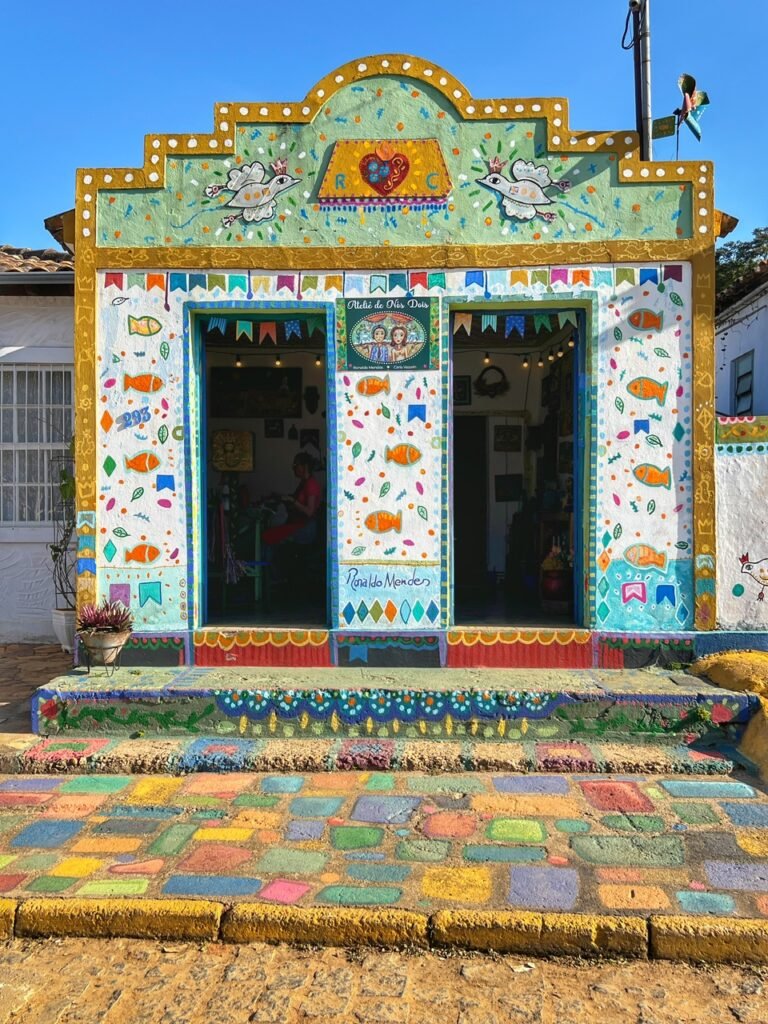
Another amusing artist’s studio.


And finally, although the journey had been fantastic, we were pretty stoked to lube up with hand sanitizer and enter the grand destination…Tempero da Ángela.


This food, slow simmered in cast iron or stone pots over open flames, for us can only be described as the kind that as Americans we grew up eating for Thanksgiving until we were so crammed with calories all we needed was a nap….savory, creamy, overindulgent comfort food…But the flavor palate is also bursting with new variety and concoctions as well, not to mention fully accepting of vegetarians.


Greg’s first heap of food is the first photo. Second, Mandy’s only, but also two additional servings of beans. They were creamy like refried beans and some of the best she’s ever had. The cost for all-you-can-eat was $52 Reais or $10.46. Some of the dishes available: tropeiro beans, tutu, chicken with okra, crackling, angu, ham, vegetables, salads, among others.
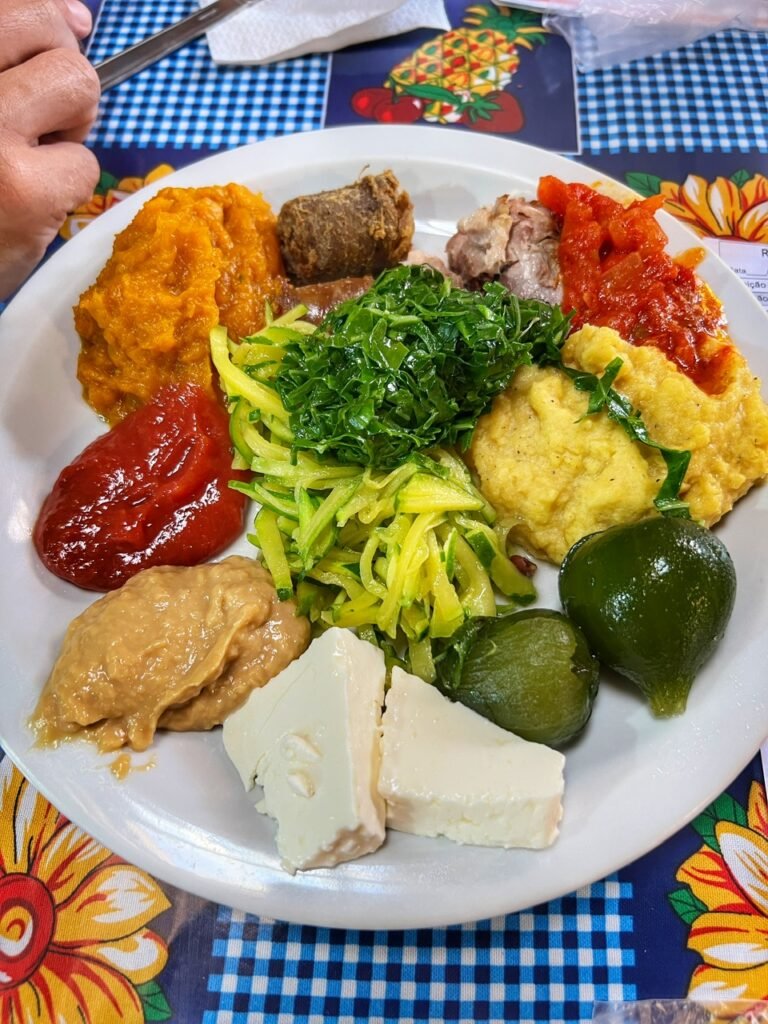

Greg’s final plate. The bottom four items are considered dessert. A berry-like jam, a peanut-flavored dulce de leche cream, Minas cheese and…the best candied figs we’ve ever had. Cinnamon, clove and just oozing with deliciousness.

Bichinho! What a fun side trip!! But seriously, thank God we got a lift back. Ugh.



